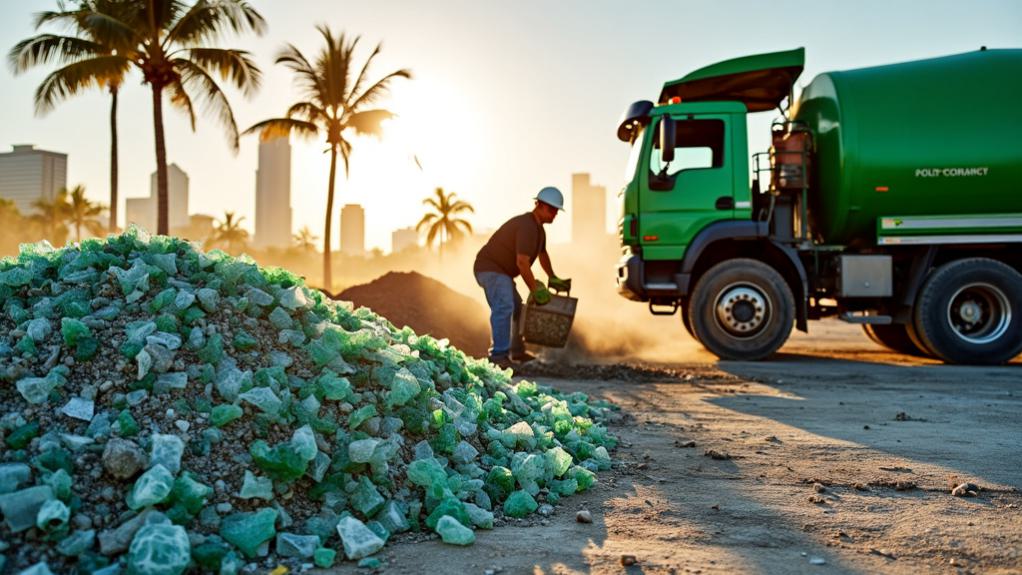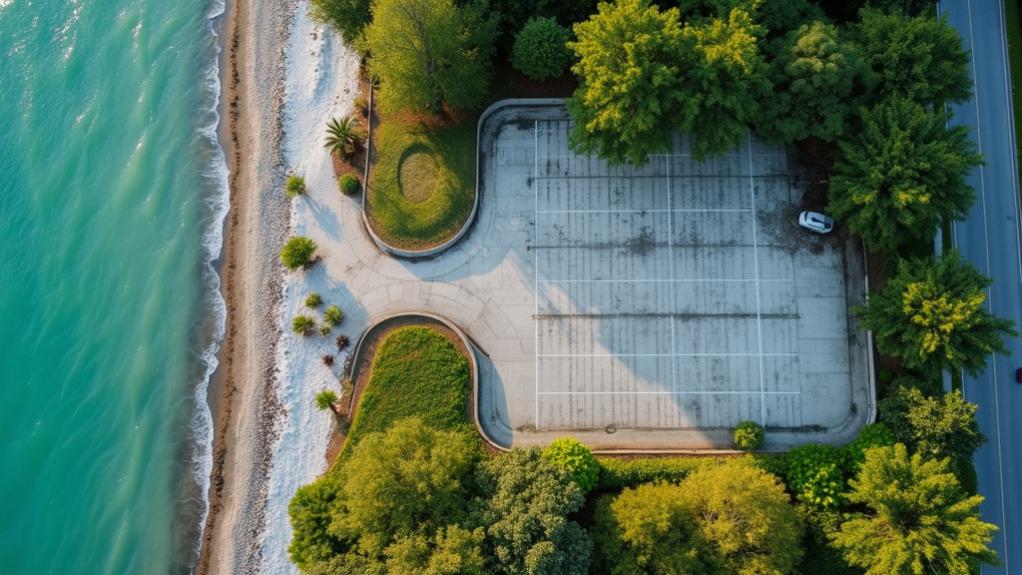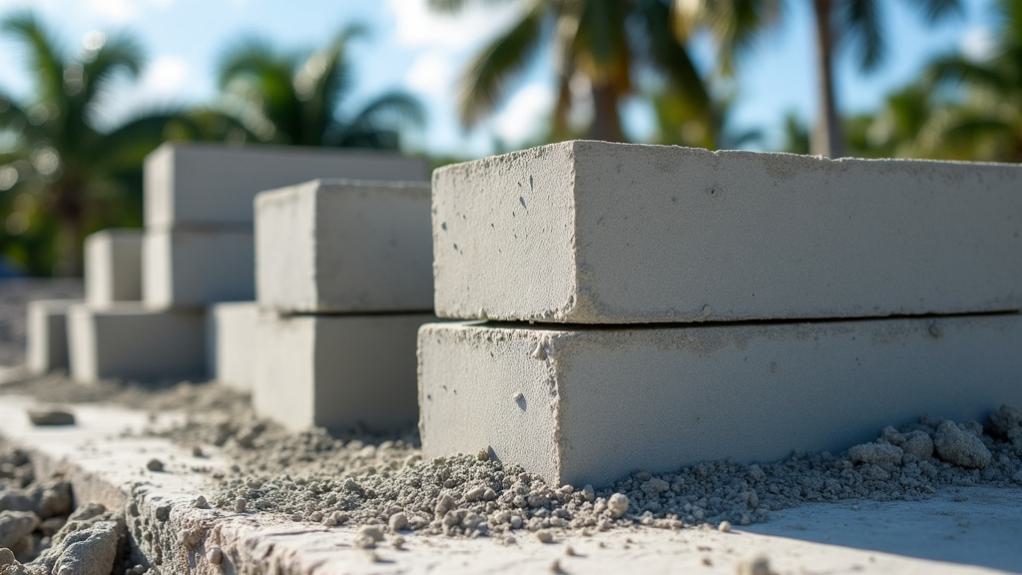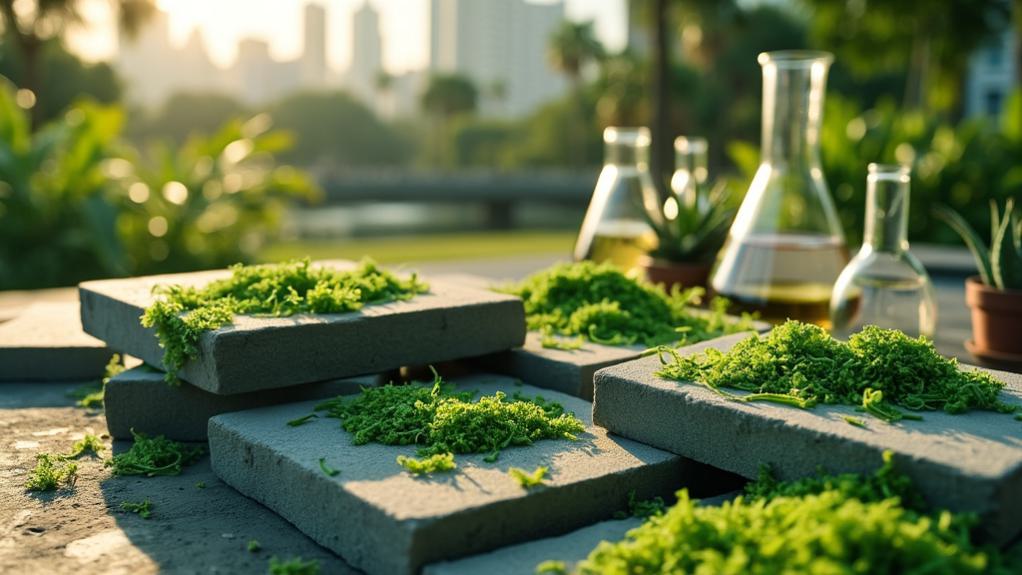Florida's construction industry is embracing sustainable concrete solutions to address environmental challenges and meet the state's growing infrastructure needs. Innovative approaches include carbon-reducing mixes, recycled aggregates, self-healing technologies, and permeable concrete for stormwater management. CO2 curing, fiber reinforcement, and bio-based additives further enhance sustainability. These solutions reduce carbon emissions, conserve resources, and improve durability in Florida's coastal environment. Initiatives focus on recycled content mandates, coastal infrastructure resilience, and habitat preservation. Proper installation and maintenance are crucial for long-term effectiveness. Exploring these eco-friendly alternatives reveals a promising future for Florida's construction sector.
The Need for Sustainable Concrete

As the construction industry grapples with its significant environmental impact, the need for sustainable concrete has become increasingly urgent. Concrete, the most widely used construction material globally, contributes substantially to carbon emissions and resource depletion. In Florida, where urban development is rapidly expanding, the demand for concrete is particularly high, exacerbating environmental concerns.
The push for sustainable concrete solutions is driven by tightening environmental regulations and a growing awareness of the industry's ecological footprint. Traditional concrete production involves energy-intensive processes and relies heavily on non-renewable resources.
Moreover, the durability issues faced by conventional concrete in Florida's harsh coastal environment lead to frequent repairs and replacements, further straining natural resources.
Sustainable concrete alternatives offer opportunities to reduce carbon emissions, minimize waste, and enhance structural longevity. By incorporating recycled materials, industrial by-products, and innovative binding agents, these solutions can significantly decrease the environmental impact of construction projects.
Additionally, sustainable concrete formulations can improve resistance to salt-water intrusion and other regional environmental challenges, reducing long-term maintenance needs and resource consumption. As Florida continues to grow, adopting sustainable concrete practices is crucial for balancing urban development with environmental stewardship.
Carbon-Reducing Concrete Mixes
Carbon-reducing concrete mixes represent a significant advancement in sustainable construction technology. These innovative formulations aim to decrease the carbon footprint associated with traditional concrete production by incorporating alternative binders and supplementary cementitious materials. By partially replacing ordinary Portland cement with materials such as fly ash, ground granulated blast furnace slag, or silica fume, these mixes can significantly reduce CO2 emissions without compromising structural integrity.
Lifecycle assessment studies have demonstrated the environmental benefits of carbon-reducing concrete mixes. These assessments consider the entire production process, from raw material extraction to end-of-life disposal, providing a comprehensive view of the environmental impact. Results consistently show reduced greenhouse gas emissions, lower energy consumption, and decreased resource depletion compared to conventional concrete mixes.
Furthermore, carbon-reducing concrete mixes often exhibit enhanced durability and resistance to chemical attack, potentially extending the service life of structures. This longevity contributes to overall sustainability by reducing the need for frequent repairs or replacements.
As the construction industry continues to prioritize environmental stewardship, carbon-reducing concrete mixes are poised to play a crucial role in mitigating the sector's climate impact and promoting more sustainable building practices.
Recycled Aggregates in Construction

Recycled aggregates represent another significant advancement in sustainable construction practices, complementing the benefits of carbon-reducing concrete mixes. These materials, derived from crushed concrete waste and other construction debris, offer a viable alternative to traditional virgin aggregates.
The use of recycled aggregates in construction projects contributes to reduced landfill waste, decreased demand for natural resources, and lower carbon emissions associated with aggregate production and transportation.
One of the primary recycled aggregate benefits is the conservation of natural resources, as it minimizes the need for quarrying and mining activities. Additionally, utilizing these materials can lead to cost savings for construction projects, particularly in areas where virgin aggregates are scarce or expensive.
However, sourcing challenges persist, including variable quality and limited availability in some regions. To address these issues, stringent quality control measures and improved processing techniques are being developed to ensure consistent performance and reliability of recycled aggregates.
As the construction industry in Florida continues to prioritize sustainability, the integration of recycled aggregates into concrete production will play a crucial role in reducing the environmental impact of built infrastructure.
Self-Healing Concrete Technologies
Self-healing concrete technologies represent a groundbreaking innovation in sustainable construction materials. These advanced systems incorporate microbial agents or other healing mechanisms that enable autonomous repair of cracks and damage within the concrete matrix. The ability for crack self-repair significantly enhances material longevity, reducing the need for frequent maintenance and replacement of concrete structures.
The environmental benefits of self-healing concrete are substantial. By extending the lifespan of concrete structures, these technologies minimize resource consumption and reduce the carbon footprint associated with concrete production and construction activities.
Innovative applications of self-healing concrete include infrastructure projects, marine structures, and underground facilities where access for repairs is limited.
Performance assessment of self-healing concrete technologies involves evaluating the efficiency of crack closure, strength recovery, and durability improvement. Researchers are continuously refining these systems to optimize their healing capabilities and ensure their effectiveness in various environmental conditions.
As Florida faces unique challenges related to coastal exposure and high humidity, self-healing concrete offers promising solutions for enhancing the resilience and sustainability of the state's built environment.
Permeable Concrete for Stormwater Management

Permeable concrete serves as an innovative solution for stormwater management, offering significant flood prevention benefits in urban environments.
This porous material allows water to percolate through its surface, reducing runoff and recharging groundwater aquifers.
Proper installation and regular maintenance are crucial for ensuring the long-term effectiveness of permeable concrete systems, including periodic cleaning to prevent clogging and preserve their water-absorbing capabilities.
Flood Prevention Benefits
A significant advantage of permeable concrete lies in its robust flood prevention capabilities. By allowing water to infiltrate through its porous structure, this innovative material significantly reduces surface runoff during heavy rainfall events. This characteristic is particularly crucial in Florida's coastal regions, where the combination of low-lying terrain and frequent storm surges amplifies flood risk.
Permeable concrete functions as a natural drainage system, effectively managing stormwater by facilitating its percolation into the ground. This process not only mitigates localized flooding but also helps replenish groundwater aquifers. In urban areas with extensive impervious surfaces, the implementation of permeable concrete can dramatically decrease the burden on traditional stormwater infrastructure.
The flood prevention benefits extend beyond immediate water management. By reducing standing water on roads and walkways, permeable concrete enhances public safety during and after storm events.
Additionally, it helps mitigate the urban heat island effect by allowing moisture to evaporate from its porous structure, contributing to cooler ambient temperatures. This multifaceted approach to flood prevention aligns with sustainable urban development practices, making permeable concrete an essential tool in Florida's climate resilience strategy.
Installation and Maintenance
While the flood prevention benefits of permeable concrete are substantial, proper installation and maintenance are key to ensuring its long-term effectiveness in stormwater management.
Installation techniques for permeable concrete require specialized knowledge and equipment. The subgrade must be carefully prepared to ensure proper drainage, and the concrete mix must be precisely formulated to achieve the desired porosity. Proper compaction and curing are critical to prevent premature deterioration.
Maintenance practices for permeable concrete systems are relatively straightforward but essential. Regular inspection and cleaning are necessary to prevent clogging of the porous structure. Vacuum sweeping or pressure washing can effectively remove accumulated sediment and debris. In areas with high pollutant loads, more frequent maintenance may be required.
Additionally, winter maintenance practices must be adapted, as traditional de-icing methods can damage the concrete surface.
Long-term performance monitoring is crucial to assess the system's effectiveness over time. This includes measuring infiltration rates, evaluating structural integrity, and analyzing water quality improvements.
Geopolymer Concrete Applications
As the construction industry seeks environmentally friendly alternatives to traditional Portland cement, geopolymer concrete has emerged as a promising solution with diverse applications. This innovative material offers superior geopolymer durability and sustainability, making it ideal for Florida's challenging coastal environment.
Geopolymer concrete can be utilized in various construction projects, including marine structures, highways, and high-rise buildings. Its resistance to chloride penetration and acid attack makes it particularly suitable for coastal infrastructure, such as seawalls, bridges, and port facilities.
The material's low shrinkage and high early strength properties allow for faster construction timelines and reduced maintenance costs.
In the transportation sector, geopolymer concrete can be employed for road pavements, airport runways, and railway sleepers. Its ability to withstand heavy loads and extreme weather conditions enhances infrastructure longevity.
Additionally, geopolymer concrete's fire resistance makes it an excellent choice for tunnels and underground structures.
The versatility of geopolymer concrete extends to precast elements, such as pipes, culverts, and retaining walls. Its use in these applications not only improves structural performance but also significantly reduces the carbon footprint of construction projects, aligning with Florida's sustainability goals.
Concrete With CO2 Curing

Innovation in concrete technology has led to the development of CO2 curing, a groundbreaking process that transforms waste carbon dioxide into a valuable resource for concrete production. This novel curing technique offers a sustainable alternative to traditional methods, effectively sequestering CO2 and reducing the carbon footprint of concrete manufacturing.
CO2 utilization in concrete curing involves injecting pressurized carbon dioxide into freshly mixed concrete. The CO2 reacts with calcium hydroxide in the cement paste, forming calcium carbonate, which enhances the concrete's strength and durability. This process not only accelerates curing times but also improves the material's overall performance.
The implementation of CO2 curing techniques in Florida's construction industry could significantly contribute to the state's sustainability goals. By capturing and repurposing industrial CO2 emissions, this method addresses two critical environmental concerns: reducing greenhouse gas emissions and conserving natural resources.
Furthermore, the enhanced properties of CO2-cured concrete make it particularly suitable for Florida's challenging coastal environment, offering improved resistance to chloride ingress and carbonation. As the construction sector seeks eco-friendly solutions, CO2 curing presents a promising avenue for sustainable concrete production.
Fiber-Reinforced Sustainable Concrete
Fiber-reinforced sustainable concrete represents a significant advancement in construction materials, offering enhanced durability and strength while reducing environmental impact.
The incorporation of fibers, such as recycled steel, glass, or natural fibers, into concrete mixtures results in a composite material with improved tensile strength, crack resistance, and overall structural integrity.
This innovative approach not only extends the lifespan of concrete structures but also allows for the use of less cement, thereby reducing carbon emissions associated with concrete production.
Enhanced Durability and Strength
Sustainable concrete's durability and strength can be significantly enhanced through the incorporation of fiber reinforcement. This innovative technique not only improves the material's mechanical properties but also contributes to its overall sustainability.
By utilizing fibers from sustainable sourcing, such as recycled plastics or natural plant-based materials, the environmental impact of concrete production can be further reduced.
The addition of fibers to the concrete matrix creates a three-dimensional reinforcement system that enhances crack resistance, flexural strength, and impact resistance. These improvements result in structures with longer lifespans and reduced maintenance requirements, aligning with sustainable construction practices.
Furthermore, fiber reinforcement allows for the reduction of traditional steel reinforcement, potentially lowering the carbon footprint of concrete structures.
Innovative additives, when combined with fiber reinforcement, can further enhance the durability and strength of sustainable concrete. These may include supplementary cementitious materials, such as fly ash or silica fume, which improve the concrete's microstructure and resistance to environmental degradation.
The synergistic effect of fiber reinforcement and advanced additives results in a high-performance, eco-friendly concrete solution that meets the demanding requirements of modern construction while minimizing environmental impact.
Reduced Environmental Impact
The environmental impact of concrete production has long been a concern in the construction industry. Fiber-reinforced sustainable concrete (FRSC) offers a solution by significantly reducing the carbon footprint throughout its life cycle. By incorporating innovative practices and technology integration, FRSC minimizes the use of traditional cement, replacing it with recycled materials and industrial byproducts. This approach not only adheres to stringent environmental regulations but also promotes responsible material sourcing and waste management.
Community engagement and educational initiatives play crucial roles in promoting FRSC adoption. These efforts raise awareness about the economic benefits and ecological advantages of sustainable concrete solutions. As a result, more construction projects are seeking green certifications, demonstrating a commitment to environmental stewardship.
The implementation of FRSC also contributes to improved air quality and reduced energy consumption during production and transportation. By embracing these sustainable practices, the concrete industry in Florida can achieve a balance between meeting construction demands and preserving the environment. This shift towards eco-friendly concrete solutions aligns with global sustainability goals and positions Florida as a leader in green construction practices.
Bio-Based Concrete Additives

Bio-based concrete additives represent a promising frontier in the quest for more sustainable construction materials. These innovative additives, derived from renewable resources, offer potential solutions to reduce the carbon footprint of concrete production while enhancing its performance characteristics.
One notable approach involves biochar incorporation, which utilizes carbonized biomass to improve concrete's strength and durability. Biochar not only sequesters carbon but also enhances the material's resistance to cracking and chemical attack.
Another significant development in this field is the use of natural fiber composites. These fibers, sourced from plant materials such as hemp, sisal, or bamboo, can be integrated into concrete mixtures to increase tensile strength and reduce overall weight.
The inclusion of these bio-based fibers also contributes to improved thermal insulation properties, making buildings more energy-efficient. Furthermore, these additives often result in decreased cement content, thereby reducing the overall environmental impact of concrete production.
As research progresses, the integration of bio-based additives in concrete formulations presents a viable path towards more sustainable and resilient infrastructure in Florida's future construction landscape.
Florida's Sustainable Concrete Projects
Florida's sustainable concrete projects emphasize recycled aggregate initiatives and coastal infrastructure resilience.
The state's construction industry has implemented programs to incorporate recycled materials, such as crushed concrete and glass, into new concrete mixtures, reducing landfill waste and conserving natural resources.
Additionally, Florida's coastal regions are developing innovative concrete formulations and structures designed to withstand saltwater exposure, storm surge, and rising sea levels, enhancing the longevity and sustainability of critical infrastructure.
Recycled Aggregate Initiatives
As part of a broader push towards sustainable construction practices, Florida has implemented several initiatives focused on recycled aggregate in concrete production.
These programs aim to reduce the environmental impact of concrete manufacturing while maintaining structural integrity and performance. The state's Department of Transportation (FDOT) has been at the forefront of these efforts, developing specifications and guidelines for the use of recycled materials in road construction and infrastructure projects.
Key aspects of Florida's recycled aggregate initiatives include:
- Mandating minimum percentages of recycled content in certain concrete applications
- Establishing quality control standards for recycled aggregate sourcing
- Providing incentives for contractors who exceed recycled material targets
- Investing in research to improve recycled aggregate performance
- Collaborating with local industries to create closed-loop recycling systems
Coastal Infrastructure Resilience
While recycled aggregate initiatives address material sustainability, Florida's coastal regions face unique challenges that require specialized concrete solutions. Coastal infrastructure resilience has become a critical focus in the state's efforts to combat coastal erosion and protect marine ecosystems.
Infrastructure adaptation strategies are being developed to enhance climate resilience and mitigate the impacts of storm surge and rising sea levels. Innovative construction practices are being implemented to create more robust coastal structures while minimizing environmental impact.
These include the use of advanced concrete mixtures designed to withstand saltwater exposure and resist deterioration in harsh marine environments. Additionally, engineers are incorporating habitat preservation features into coastal infrastructure designs, such as textured surfaces that promote marine life colonization.
Environmental regulations play a crucial role in guiding these sustainable concrete projects, ensuring that material sustainability is balanced with ecosystem protection. By prioritizing coastal infrastructure resilience, Florida aims to safeguard its shorelines, protect valuable assets, and maintain the delicate balance of its coastal ecosystems in the face of climate change and increasing environmental pressures.
Conclusion
Florida's sustainable concrete initiatives represent a critical step towards reducing the environmental impact of construction while enhancing infrastructure resilience. Carbon-reducing mixes, recycled aggregates, self-healing technologies, and permeable solutions address key sustainability challenges. CO2 curing, fiber reinforcement, and bio-based additives further advance concrete's eco-profile. As climate change intensifies, widespread adoption of these innovative concrete solutions will be essential for Florida's coastal communities to mitigate environmental degradation, improve stormwater management, and create more durable built environments aligned with long-term sustainability goals.
